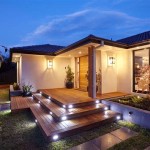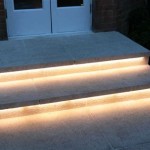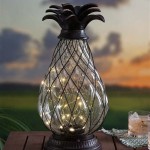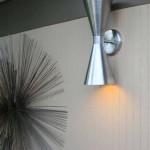```html
Outdoor Up Lighting: Enhancing Aesthetics and Security
Outdoor up lighting is a technique used to illuminate features on the exterior of a building or landscape from a ground-level or below-ground position. This approach casts light upwards, accentuating architectural details, trees, shrubs, and other outdoor elements. The strategic placement of up lights can dramatically enhance the aesthetic appeal of a property, creating a visually striking nighttime environment. Beyond aesthetics, up lighting also plays a significant role in improving safety and security by illuminating pathways and deterring potential intruders.
The principles behind effective outdoor up lighting involve careful consideration of several factors. These include the type of fixtures used, the wattage and color temperature of the bulbs, the angle of the light beam, and the overall layout of the lighting design. A well-executed up lighting scheme is not simply about adding light; it's about creating visual interest and depth, highlighting textures, and creating a welcoming and secure atmosphere.
Understanding the Benefits of Up Lighting
The implementation of outdoor up lighting offers a multitude of advantages, extending beyond mere visual enhancement. Property owners often choose up lighting for its combined ability to improve aesthetics, security, and property value.
One of the primary benefits is its ability to enhance architectural features. Buildings with interesting facades, columns, or other unique details can be brought to life at night with strategically placed up lights. This technique draws attention to these elements, transforming the building's nighttime appearance and creating a more sophisticated and inviting ambiance. Up lighting can also accentuate the texture of building materials, such as brick, stone, or wood, adding depth and character to the overall design.
Beyond architecture, up lighting is highly effective for highlighting landscape elements. Trees, in particular, are often a focal point of up lighting designs. The upward cast of light reveals the tree's structure, branches, and foliage, creating a dramatic and visually appealing effect. Shrubs, sculptures, and other garden features can also be effectively illuminated, adding depth and dimension to the outdoor space. A well-designed landscape up lighting scheme can transform an ordinary garden into a captivating nighttime oasis.
Security is another crucial benefit. By illuminating the perimeter of a property, up lighting can deter potential intruders. Well-lit areas reduce the risk of criminal activity by eliminating dark hiding spots. Up lighting can also improve visibility around walkways, driveways, and other high-traffic areas, reducing the risk of accidents. In addition, motion-activated up lights can provide an extra layer of security, instantly illuminating an area when movement is detected.
Finally, the implementation of a well-designed up lighting system can increase property value. A visually appealing and well-maintained exterior suggests a property that is cared for, making it more attractive to potential buyers. The added security features also contribute to the perceived value of the property. By investing in quality up lighting, property owners can enhance the curb appeal and overall value of their homes or businesses.
Choosing the Right Up Lighting Fixtures
Selecting the appropriate fixtures is critical to the success of any up lighting project. The market offers a wide variety of options, each with its own advantages and disadvantages. Factors such as the type of bulb, the material of the fixture, the beam angle, and the overall design should be carefully considered.
There are several types of bulbs commonly used in up lighting fixtures. Traditional halogen bulbs offer a warm, bright light but are less energy-efficient and have a shorter lifespan compared to other options. LED (Light Emitting Diode) bulbs are becoming increasingly popular due to their energy efficiency, long lifespan, and versatility. They come in a variety of color temperatures and brightness levels, allowing for greater customization. While initially more expensive than halogen bulbs, LEDs offer significant long-term cost savings due to their lower energy consumption and reduced maintenance requirements. Solar-powered up lights offer another energy-efficient option, eliminating the need for electrical wiring. However, their performance can be affected by weather conditions and the amount of sunlight they receive.
The material of the fixture is also an important consideration, particularly in terms of durability and weather resistance. Common materials include aluminum, brass, copper, and stainless steel. Aluminum is lightweight and relatively inexpensive but may be prone to corrosion in certain environments. Brass and copper are more durable and offer a more traditional aesthetic, but they can be more expensive. Stainless steel is highly resistant to corrosion and is a good choice for coastal areas or other harsh environments. Consider the surrounding environment and choose a material that will withstand the elements and maintain its appearance over time.
The beam angle of the fixture determines the width of the light beam. Narrow beam angles are ideal for highlighting specific architectural details or creating a dramatic spotlight effect on trees. Wider beam angles are better suited for illuminating larger areas or washing a wall with light. Adjustable beam angles offer the most flexibility, allowing you to customize the lighting effect to suit your specific needs. The choice of beam angle should be based on the size and shape of the object being illuminated, as well as the desired aesthetic.
Finally, the overall design of the fixture should complement the architectural style of the building and the landscape design. There are many different styles of up lighting fixtures available, from traditional to contemporary. Choose fixtures that blend seamlessly with the surroundings and enhance the overall aesthetic of the property.
Implementing an Effective Up Lighting Design
Successfully implementing an outdoor up lighting design requires careful planning and execution. It's not simply about placing lights around the property; it's about creating a cohesive and visually appealing lighting scheme that enhances the beauty and security of the space. Key considerations include planning, placement, and professional assistance.
The initial planning stage involves assessing the property and identifying the key features that you want to highlight. This includes architectural details, trees, shrubs, and other landscape elements. Consider the desired effect and how the up lighting will interact with the existing landscape lighting. Create a sketch or plan of the property, marking the location of each fixture and noting the desired beam angle and brightness level. Careful planning will help to ensure that the final result is both aesthetically pleasing and functional.
Proper placement of the fixtures is crucial for achieving the desired effect. Experiment with different angles and positions to determine the most flattering illumination for each feature. Position lights to avoid glare and light trespass onto neighboring properties. Consider the height and spread of trees and shrubs as they mature, and adjust the placement of the lights accordingly. In general, it is better to use multiple low-wattage lights than a single high-wattage light, as this will create a more even and natural-looking illumination.
For complex up lighting projects, it may be beneficial to consult with a professional lighting designer or installer. A professional can provide expert advice on fixture selection, placement, and wiring, ensuring that the project is completed safely and efficiently. They can also help to create a custom lighting design that meets your specific needs and budget. While hiring a professional may involve additional costs, it can save time and money in the long run by avoiding costly mistakes and ensuring a high-quality result. A professional can also ensure that the up lighting system complies with local building codes and regulations.
In conclusion, thoughtful planning and consideration regarding fixture selection, placement, and professional guidance are all critical components in achieving a successful and satisfying outdoor up lighting design.
```
4 Ways To Use Uplights Outdoor Lighting Rensen House Of Lights

Up And Down Exterior Lighting Ideas Seiler S Landscaping Cincinnati

How To Secure Your Home With Outdoor Lighting The Perfect Light

Diy Outdoor Lighting Projects Screen Enclosure

10 Outdoor Lighting Trends For 2024 The Perfect Light

Diy Outdoor Lighting Brighten Your Evenings Now S

How To Choose Outdoor Lighting For Enjoyment And Safety Burkholder

Outdoor Lighting Maintenance Dallas Fort Worth Creative Nightscapes

Is Smart Outdoor Lighting Right For Your Home

Outdoor Led Uplight American Party Lights
Related Posts







